


An introduction to the ancient people of Namibia who left their mark in the form of thousands of petroglyphs and pictograms, and to the wonderful desert-adapted elephants, who peacefully allowed us to observe them feed, play and mock fight.


From Swakopmund we had quite a long drive to Damaraland so we made an early start. The first stretch of road alongside the Skeleton Coast was decent and we spotted the only wreck on this part of the shore - it's the wrecks which give it its name.
On to Uis and still the road wasn't bad at all but from there it deteriorated rapidly and was terrible all the way to the district border, the worst road we'd been on - it must have been long overdue a visit from a grader! It was a real relief to cross the border and drive on better roads.

Damaraland looked very, very dry and inhospitable. The landscape was very rocky, all the grasses were dried out, all the trees low and very tough-looking. No doubt when the rains come it turns green very quickly.


We were staying at Camp Kipwe, a wonderful lodge, each room hidden in the rocks, a cave-like dwelling with outdoor, open-air - though private and hidden - bathrooms. We loved it, though the relief manager Derek, was quick to apologise for the rather worn look of the bedroom walls as they were all undergoing redecoration.

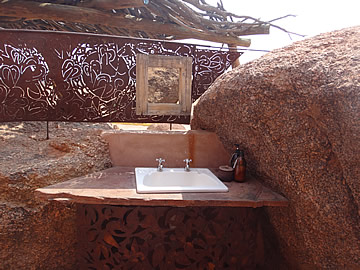

We were in quite a remote region surrounded by plains and low rocky mountains with not another sign of civilisation in sight. It was very peaceful.


That afternoon we went out with an extremely good guide, Tafi, to see the petroglyphs of Twyfelfontein.
The name means "uncertain" or "doubtful" spring. A white man tried to settle here in the late 1940s with grazing animals. The spring being small and unpredictable this was a very difficult way to support a family.

The farmhouse now stands in ruins but the name is associated with an area which has one of the highest concentration of petroglyphs in Africa.
Before we reached the ruin Tafi had already shown us some of the oldest petroglyphs left by hunters-gatherers, thought to be up to 6000 years old.

UNESCO regards the site as a "high quality record of ritual practices relating to hunter-gather communities in this part of southern Africa over at least two millennia and eloquently reflects the links between ritual and economic practices of hunter-gatherers in terms of the value of reliable water sources in nurturing communities on a seasonal basis".1


Over 5,000 individual figures have been recorded. The petroglyphs are regarded as the authentic work of San hunter-gatherers who inhabited this region long before Damara herders and Europeans arrived. Apart from one small panel which was removed to a Windhoek museum, and rock falls, the site is untouched, remaining much as the people who created the engravings would have known it.1
The marks are fascinating. The oldest that Tafi showed us first are mostly symbolic. Many are simple dots, probably of religious shamanic meaning.
There were also different marks for types of water holes: a circle with a central dot was permanent, a circle with a vertical line extending from the bottom was temporary, draining away. Other marks near to these could be landscape features which would help in locating the water holes.



Tafi then led us to one of the most prolifically engraved of the rocks, covered with images of animals: giraffe, lion, elephant, rhinoceros, antelope.
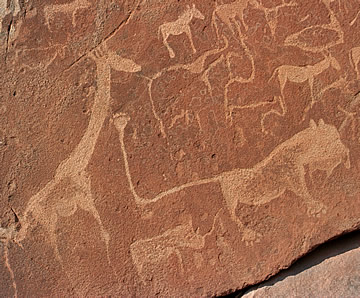
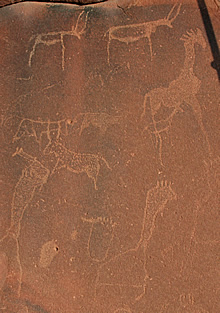
We walked a trail examining several rock faces which have more animals, lots of giraffes, and one with the only known depiction of a human, who looks as if he is strangling an ostrich!




We then came to a really interesting large rock with a series of instructional petroglyphs. Tafi explained that these show animals and their footprints and it would have been used to pass on knowledge about which animals should be avoided (cats), which are good to eat and which will lead you to water.
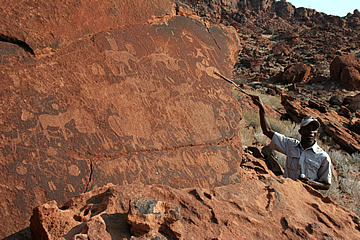

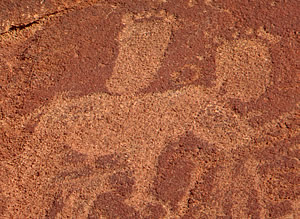
It was absolutely fascinating. Tafi said that, although the hunter-gatherers whose distant ancestors created these engravings no longer inhabit the area, there are descendants living not too far away who have been able to help with deciphering the petroglyphs.



I find looking at these ancient engravings absolutely fascinating. It is marvellous to think that we were standing in the place where these long-ago people scratched out the beginnings of an education system.

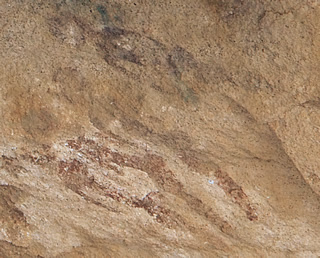

On the way out Tafi showed us some of the very rare pictograms which have survived only because they are well-sheltered from the elements under the lip of a large rock. We could take photos but of course no flash was allowed.
These were recognisably human figures, painted in red and blue pigments on a white ground - someone actually stood or sat in front of this rock and carefully painted these figures - amazing!
We'd spent quite a long time looking at the petroglyphs - this was a very good visit, enhanced by Tafi's expert guiding.
Burnt Mountain, which we went to next, was a bit of an anti-climax, a rather unstable shale hill of volcanic origin. Because of its instability there are signs asking that visitors not climb it, which didn't deter a couple of French-speakers who felt it didn't apply to them!

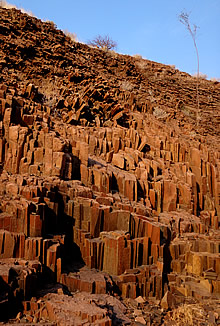
Rather more interesting are the Organ Pipes, basalt columns reminiscent of a mini Giant's Causeway, hundreds of columns exposed on a hillside.
That evening we had sundowners on the hilltop behind Camp Kipwe watching the sun turn red and sink below the horizon, followed by a very good meal in the open dining room - a fine end to a very good day.


The next morning we had another early start after a very good breakfast - the food was consistently good at Kipwe. Today we were looking for plant and animal life, most particularly desert elephants.
We were driving through completely wild country with no-one else in sight - and we could see for miles across the dry plains to flat-topped mountains in the distance.

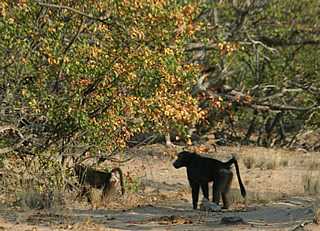

We saw a lovely Secretary Bird, stately ostriches and baboons with Tafi all the time looking for elephant tracks and fresh droppings.







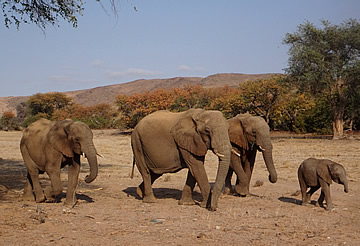

Tafi was supremely good at elephant tracking and it didn't take him long to pick up tracks and soon we were watching Rosie's group, a herd of 14 with Rosie the matriarch, females, an elderly grandmother, 2 or 3 young males and a thirteen month old calf. It was absolutely blissful watching these elephants over a period of hours as they grazed the vegetation, wandering slowly across the parched ground.


At one point two young males were mock-fighting only a few metres from us. Tafi said that as long as we stayed within the confines of the open-sided vehicle we would be safe.
The landscape is very dry, verging on desert with sandy dunes not too far away. But the dry river bed is lined with hardy trees which provide food.

We moved a little further off to have the coffee that had been packed for us. We were able to get out and watch the herd in the middle-distance. It was wonderful to watch these animals going about their daily business in the wild. They seemed not to notice us but I'm sure they were aware at least of the vehicle.


























We returned to Kipwe for a very good lunch before heading to the Doro Niwas airstrip for the flight to Hoanib. We only wish we could have stayed at least another day.






A final flourish from Kipwe - a magnificent Agama lizard appeared and posed on the rocks just before we left!